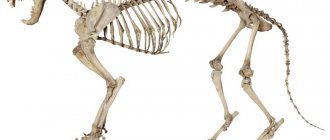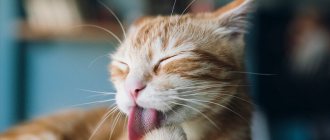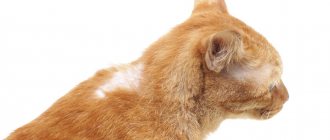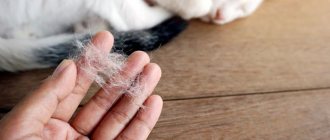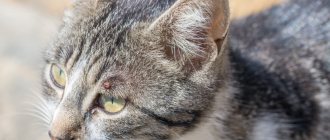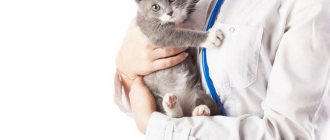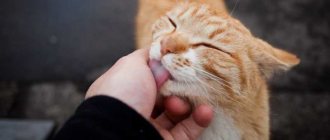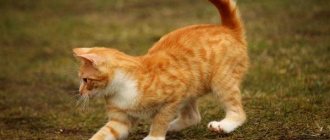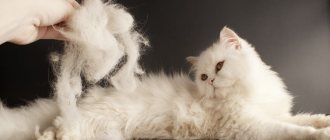In some situations, pet owners turn to veterinarians with complaints that the cat’s tail has become thinner at the base and has become covered with a layer of dense fat that is difficult to remove.
Cat owners are interested in what to do in such a situation, how to get rid of oiliness, and why blood may ooze from the affected areas of the tail skin. Most likely, in this case, the doctor will answer that the cat has a disease called “greasy tail.”
Causes
Disease on a pet's tail can occur for various reasons. Often these are: long-standing injuries, severe bruises, wounds, fractures or any other damage. Sometimes, but there are still diseases that are quite difficult to determine. These include: tumors, unknown neoplasms, eczema, osteomyelitis. Any of them requires high-quality qualified treatment in compliance with all requirements and recommendations of a veterinarian. Every loving owner should know why such diseases occur and how to deal with them.
© shutterstock
conclusions
These are the main reasons why a cat's fur may look greasy and unkempt. Some of them go away on their own; in other cases, veterinary intervention will be required. With competent actions by the owner, if oily fur is detected on a pet, the problem can be eliminated in just a few days, returning the animal’s fur to its former shine and beauty.
The problem of oily fur goes away within a few days with the correct actions of the owner.
Treatment options
Treatment for a cat with “greasy tail” will most likely be lengthy and not the most pleasant for both the owner and the animal itself. If your beloved Scotsie or other breed just doesn't want to bathe, he'll need to be bathed regularly using a shampoo like Lactaderma, which contains lactic acid.
It promotes good washing of fur and skin without drying it out, and also helps to gently exfoliate keratin accumulations. After such care, even the laziest cat’s fur will stop getting greasy and become beautiful and fluffy.
If the problem is caused by high hormonal levels, the doctor will recommend castration or other procedures. If the anal glands are to blame, they can be washed or emptied manually. If the disease recurs regularly, the veterinarian will train cat owners to do this at home. If the disease is chronic or severe, surgery to remove the glands may be recommended.
As a general tonic, the veterinarian can give recommendations on the use of special vitamins, as well as change the usual diet.
In the presence of acne, increased keratinization, and blackheads on the skin, special shampoos are used. From a large list of such products, we can name Dermilen and Meladerm. They are aimed at treating oily seborrhea and can prevent the spread of the disease, prevent the infection from “settling” and the development of chronic eczema.
Treatment of a cat's tail can be complex and lengthy, but it must be done, since without proper attention to the problem, irreparable changes can develop, in particular, the cat can be left with a hairless tail, like a rat's.
Why does my cat have oily fur and brown spots?
This may be a symptom of one of the diseases associated with improper functioning of the sebaceous glands in the animal's body.
Oily hair on a cat's tail may be a symptom of malfunctioning sebaceous glands.
Its cause, in turn, can be infection, hormone release, and much more.
The most harmless reason is the play of hormones
If you are the happy owner of an unneutered cat, and you notice he has oily fur and strange spots in the tail area, then there may be no reason to worry.
During puberty
the animal's body may secrete more fat than usual, as hormones activate the sebaceous glands. This excess remains on the fur, giving it an unkempt appearance.
During puberty, a cat's body produces large amounts of fat.
Young cats
Most often, this effect can be observed in young cats that have not yet been mated with females.
Usually, unpleasant symptoms disappear immediately after the animal’s hormonal levels improve, that is, upon completion of puberty.
Upon completion of puberty, unpleasant symptoms immediately disappear.
What to do?
If your pet is not bothered by oily fur, and stains (if any) do not cause discomfort, then special measures should not be taken to eliminate oily fur.
The only thing is that you can comb your cat’s tail more often to give it the most well-groomed appearance. But it is also important not to overdo it, otherwise, due to active combing, there may be a risk of partial baldness of the tail.
If the problem does not disappear within a year or longer, then perhaps the cat should be neutered.
. Usually, in the first month after castration of the pet, the activity of the sebaceous glands returns to normal, and the coat ceases to be greasy.
The cat should be neutered if the problem does not go away within a year.
Inflammation of the paraanal glands
There are a pair of glands located in the tail area of cats.
, responsible for isolating a special secret. They perform different functions, depending on the situation. For example, if an animal intends to scare away an enemy, the glands will secrete a substance with a pungent odor. When the cat is ready to get closer, they, on the contrary, secrete a secret that attracts individuals of the opposite sex.
Unfortunately, the anal glands can often become clogged and inflamed, causing them to malfunction.
One of the most common signs of such a malfunction can be such phenomena as greasy hair on the cat’s tail and brown spots, sometimes accompanied by peeling.
When the paraanal glands become inflamed, the cat may experience peeling.
Animal behavior
Another obvious symptom of malfunctioning paraanal glands is the behavior of the animal. The cat, experiencing discomfort in the anus, begins to rub its butt against any surface, be it the floor or the back of the sofa.
And also he can:
- lick the tail area frequently;
- experience pain when visiting the toilet.
A cat may experience pain when visiting the toilet if there is a problem with the paraanal glands.
To relieve your pet of problems associated with inflammation or blockage of the glands, you need to consult a veterinarian
, who will carry out the necessary procedures for cleaning them. But the specialist will also prescribe strengthening vitamins and other medications to relieve inflammation and increase the animal’s immunity.
Oily seborrhea in a pet
Another reason for the appearance of greasy marks in the tail area of a cat can be seborrhea.
This is a fairly common disease, especially among uncastrated and unsterilized animals, which manifests itself. Yes, yes, our pets can also develop this unpleasant disease!
Oily seborrhea in a cat.
Symptoms of dandruff
Symptoms of dandruff in a cat:
- oily and unkempt fur (most often on the tail and near the tail);
- small brown or yellow spots;
- peeling of the skin;
If your cat has oily hair on his tail and brown spots, and you suspect that it is seborrhea, then it is recommended to immediately show the animal to a veterinarian. The specialist will make a diagnosis and prescribe treatment.
To make a diagnosis, you should take your cat to a veterinarian.
Common diseases
Vertebral caries. The main cause of the disease is a lack of calcium, which occurs as a result of impaired metabolism. If you feel a cat's tail, you can feel formations on it; they resemble beads strung on a thread. If left untreated, the tail will completely lose its mobility, stop bending, and the pet will feel discomfort all the time.
Osteomyelitis is a disease that is caused by inflammatory processes in the bone marrow of the tail. This leads to serious injuries and infectious diseases. The most important symptoms are: lameness of the cat, pain when pressing the tail, lack of appetite. Sometimes, the presence of purulent ulcers may indicate that a sore has appeared.
Symptoms of the disease
It is believed that cats are more susceptible to this disease than others, but it can also occur in cats. Moreover, some breeds are more at risk than others of developing such an unpleasant and difficult-to-treat disease. For example, the Scottish Fold cat is often noted to have a hard tail, while according to breed standards its mobility is especially valued. With such a disorder, a “greasy tail” may also occur.
But the Persian cat is more susceptible to acne, which causes her not just discomfort, but can cause a serious illness. In addition, representatives of any breed, and even outbred cats, can have a fat tail.
In short-haired or “hairless” breeds, it is much easier to detect such a defect, but it is much more difficult to detect it in an animal with a luxurious, bushy tail. Most often, it is discovered by chance, when the process has already started and done its dirty deed.
Greasy tail syndrome is accompanied by the following symptoms:
- The fur at the base of the tail becomes very greasy, covered with thick secretions, which are very difficult or impossible to wash off using simple methods, at least from the first approach.
- On the skin at the base of the hairs you can see tubercles, which can be inflamed, covered with rough scales, and a purulent crust.
- When the disease is advanced, a whole scattering of inflamed pimples or scars from scratching may be found on the skin.
- When the fur suffers from greasy hair, it can break off at the base, leaving the affected area exposed or looking as if the hair has been clipped or pulled out.
- When the anal glands are inflamed, the animal tries to get rid of their excess contents by crawling with its backside on the floor, and sometimes on the carpet.
- With acne, a greasy yellowish spot first appears on a cat's fur, then a “black dot”, and in the absence of care and treatment, a hard crust forms, under which there may be an inflamed or abscessing acne.
Video on how to care for a cat's fur
According to veterinarians, increased secretion of fat at the base of the tail is due to several factors: metabolic disorders, lack of hygienic care or incorrect approach to cat hygiene, high hormonal levels, and heredity. In this article we will touch upon the issues of hygienic tail care.
If we consider “woolen” breeds, outwardly everything may look quite well. When examining a cat's tail superficially, it is not always possible to notice existing problems, because at first glance it is not clear how exactly the sebaceous glands function.
The upper part of the hairs is ventilated naturally, and it seems to us that everything is relatively normal. But if you part the hair, you will notice that the guard hairs at the root are greasy, there may be dandruff on the skin, an incomprehensible brownish coating covering the base of the hair.
Upon closer examination of the skin, you can sometimes find pores completely clogged with sebaceous secretions, even blackheads. Such problems are extremely rare in furry cats. Most often they make themselves felt in cats of the and breeds. It is worth noting that this is most pronounced in active sexually mature cats and to a slightly lesser extent in cats.
Unfortunately, even after this, the functioning of the sebaceous glands does not stop, but is only minimized. If you do not pay enough attention to tail care, this small untidiness can develop into a real problem: blood circulation in the skin capillaries is disrupted, the hair roots do not receive the necessary nutrition, and as a result, the hair breaks at the very base.
In extreme cases, all this leads to inflammation of the sebaceous glands, but this is a serious task for a veterinarian, and it is easier to prevent than to solve it with the help of a specialist.
Unfortunately, even the best and most professional shampoo does not always wash the tail to the desired cleanliness. Under the influence of warm water and shampoo, the fat localized at the location of the sebaceous gland is smeared throughout the tail.
So what should we do about it? In any case, do not try to pre-wash the tail with dishwashing liquid or soaking work clothes. Of course, such products are designed to remove the most serious contaminants, but your cat is not a saucepan or a car mechanic’s robe, he is alive and requires humane treatment.
Think about how you would feel about a hairdresser’s offer to wash your hair with something like this “to make your hair look better”! Among other things, the most carefully guarded organs of animals are located close to the tail of cats. What will happen if such a “nuclear” liquid gets on the mucous membranes of the genital organs?
Let's choose a more humane way. Let's remember the advice of our grandmothers. They cleaned their fur coats and hats with potato starch
! The starch granule is soft and does not damage the hair. The mass of starch perfectly absorbs all fatty secretions.
1. Before washing, sprinkle the fur at the root of the tail with starch, sorting it into partings. Gently shake the tail so that the starch “reaches” the skin and “envelops” all the hairs. Carefully and carefully comb out the starch with a slicker or a fine comb. By the appearance of the combed mass, you can easily determine whether the animal’s tail is somewhat dirty, and whether the procedure needs to be repeated for more thorough cleaning.
2. Fatty starch, combed out of the tail wool, collects into small balls: from snow-white it turns yellowish. The process must be repeated until the starch begins to crumble. Unfortunately, such a procedure can be quite time-consuming. It is not always possible to clean everything in one go. Cats are very sensitive to their tails and do not always patiently tolerate any procedures performed on them. Don't be upset if the cat leaves and you haven't finished the process yet. Given this circumstance, you can carry out this procedure for several days. . . 3. Pre-cleaning with starch does not harm the health of the animal, because starch does not dry out the fur and skin. After cleaning, wash the entire animal using a professional pet shampoo, and be sure to rinse the fur (including the tail) with conditioner. I think the result of such work will only please you.
All of the above concerned “wool” cats and cats. But what to do if there is no hair at all? It happened to me that someone, in order to dry the greasy places on a cat’s tail, wiped it with alcohol. But after exposure to alcohol, the skin dries out, depriving it of the necessary moisture, and the body, trying to replenish moisture loss, will most likely begin to secrete even more fat. Trouble can develop into a big problem.
Hairless cats need to be groomed, and this should be done regularly, using professional animal cosmetics. Choose a mild shampoo that does not contain harsh detergent ingredients. After shampooing, be sure to rinse your animal with conditioner, which will maintain the natural moisture balance of not only the coat, but also the skin.
Symptoms of cat diseases are described with the goal that a caring owner can promptly detect the onset of a serious disease, and if it is detected, immediately contact a professional veterinarian rather than self-medicate.
If the initial symptoms of an impending disease are identified in time, this will help prevent further development of the infection in your pet’s body, as well as avoid a situation where the consequences may be irreversible.
Tail disease in cats can occur for various reasons. These may be previously experienced injuries, such as bruises, wounds, fractures, dislocations or some other biomechanical damage. There are diseases that are quite difficult to determine: these are foreign tumors of various origins, osteomyelitis, eczema, vertebral caries or contractures and others. Any of these diseases requires specific treatment, which must be carried out either in a veterinary clinic or at home, but in strict accordance with the recipes and recommendations given by a professional veterinarian.
Tail hair loss
The following symptoms symbolize this problem::
- the presence of bald spots;
- on the upper part of the tail, at its base, the hair has become greasy, greasy and constantly rolls down;
- Under the fur you can find a discharge that is oily and brown in color.
The cause of tail baldness may be a disruption in the functioning and functionality of the glands that produce fat. If fat production is disrupted, then the above changes occur, the skin balance is disrupted and the pet suffers.
Taking care of our pets
Every cat owner should have a clear idea of what diseases he may encounter in his animal. Veterinarians often advise washing cats' anal openings with soap and water. This procedure has a stimulating effect on the anal glands, helping them to cleanse themselves. We also appeal to attentive owners who take their pet for examination at an animal care center - remind the veterinarian about a routine examination of the secretion sacs.
Since the animal experiences pain and shows aggression when performing manual manipulations to remove secretions, it is recommended to contact a specialist. At the Ya-Vet help center, experienced doctors will show you professional, fast help at low prices for your pet. We show love to animals by keeping them healthy!
Dog owners are well aware of possible problems with the anal glands. These are the characteristics of the canine family. However, there is a lot of information about cats. Inflammation of the paraanal glands in cats is not such a common occurrence, since canines and cats are anatomically and physiologically different, although both are human pets.
Excess fatty acids
Essential fatty acids (vitamin F) should make up about 2% of the total calorie intake. The optimal ratio of Omega-3 and Omega-6 acids is important. At the same time, cats require both linoleic and arachidonic acids from Omega-6. Their deficiency in the body is considered a rare disease and is observed mainly in cats and kittens on vegetarian diets.
Symptoms:
- generalized flaking, dull coat;
- oily seborrhea and with increased formation of earwax;
- accession, development of yeast fungi;
- areas of weeping eczema;
- poor wound healing;
- dysfunction.
Feeding balanced foods with added fatty acids prevents such problems.
Rancidity products (reactive peroxides) accumulate in the subcutaneous fat, and the fat changes color from white to yellow. “Yellow fat disease” affects young obese cats.
General signs:
- animals are not able to jump or move quickly;
- loss of appetite;
- depression, oppression.
Skin lesions:
- Severe pain when trying to lift the animal, caused by inflammation of the subcutaneous fatty tissue.
- Nodular subcutaneous fat deposits and tissue fibrosis, most commonly in the groin and lower abdomen.
- The surface of the skin appears undamaged.
When making a diagnosis, it is necessary to exclude infectious causes of nodular skin diseases. Information about the type of food is important. If necessary, a biopsy is taken, then the fat samples have a characteristic brown/orange color.
The disease may result from excessive addition of fish oil or from eating large amounts of liver. Vitamin A is a fat-soluble vitamin and is processed in the liver. Since it tends to accumulate in the body, hypervitaminosis A is more often observed in older animals (over 8 years).
General symptoms:
- loss of appetite, weight loss;
- stiffness of the joints (exostoses form around), especially the forelimbs;
- spondylitis of the cervical spine.
Skin lesions:
- hyperesthesia – increased sensitivity of the skin to normal touch;
- the cat neglects grooming (cannot lick itself), the fur becomes unkempt, and seborrhea appears.
With such a disease, the prognosis should be cautious - even with dietary adjustments, the changes that have occurred in the body may be irreversible. Balancing the diet can be difficult, as with other fatty foods.
Ulcers
More often, ulcers occur in short-haired four-legged friends. They can appear along the entire length of the tail, often affecting the root, and this can cause necrosis of the tissues and vertebrae of the tail.
An ulcer on the tail requires serious treatment and attention from the owner. If a crust has formed on it, then it must be removed from there and the wound must be cleaned of suppuration. Be sure to treat everything with an antiseptic for cats. Also, it is worth treating it with ointment (Vishnevsky, streptomycin) and applying a bandage.
© shutterstock
In advanced cases, the cat may develop gangrene, blood poisoning and serious consequences.
Diagnostic measures
Only a veterinarian can accurately answer the question of why the cat’s fur has become fat and what to do to restore it to its former beauty and healthy shine. Diagnosis of a suspected disease involves a preventive examination by a veterinarian. During this procedure, a specialist examines the pet and, if necessary, recommends passing appropriate tests. If, in addition to greasy fur, the cat's skin is flaky and itchy, or dandruff appears, he should also be shown to a dermatologist.
Fractures and other injuries
Tail injuries are the most common disease. The most common problems with the tails of cats are injuries, namely dislocations and fractures, etc. Fractures can be closed or with open wounds. In the place where the tail is broken, broken or bruised, in most cases a tumor forms, in the place of which the animal experiences pain when touched. If it happens that you find an open wound, then be sure to go to the veterinarian, not forgetting to first treat the wound with any antiseptic, for example, hydrogen peroxide. This will help avoid infection. If the tail is severely bruised, or you suspect a closed fracture, an ice compress should be applied to the injured area, which can be done using a heating pad or a regular cloth. Ice will relieve pain and reduce swelling. At the veterinary clinic, you will definitely be asked to take an x-ray of your pet’s tail, and based on the image obtained, he will be given the necessary assistance and further treatment will be prescribed.
There are pussies that cannot be scared by tail diseases.
If you find an error, please select a piece of text and press Ctrl+Enter.
Drugs used
To successfully treat an animal, the use of any one remedy is not enough. Therapy must be comprehensive. Medicines should be used both internally, to suppress microflora, and locally.
Ointments
Ointments and liniments have a fatty base, which contributes to:
- rapid absorption of the active principle;
- preventing drying out of serous and mucous membranes;
- softening of tissues, as well as dried “crusts” and their rejection.
If there are no wounds or tears, there is no point in using ointments. Some substances can be absorbed through the skin, but no strong effect is felt.
If there is an abscess or purulent cavity, then applying ointments will help relieve inflammation, but at the same time it is necessary to remove the purulent masses and excise the pockets so that the contents do not linger.
The inconvenience of using ointments for the sub-tail area is that the cat sits down and wipes the ointment on the floor and bedding.
It’s a completely different matter when the drug “Olazol” is used. When shaking the bottle, a foamy mass forms. Through the nozzle it can be easily inserted into the lumen of the rectum. By doing this regularly, you can quickly create the necessary concentration of the active principle in the tissues and relieve inflammation. The base is chloramphenicol and sea buckthorn oil. The drug is effective for paraproctitis and the cat recovers quickly.
The following can be used as ointments:
- levomekol;
- levosin;
- chloramphenicol - gel;
- syntomycin liniment;
- gentamicin ointment.
The ointment should be applied at intervals of 1-2 hours into the wound cavity. If there is no wound, then apply the ointment alone to a cotton swab and insert it into the cat’s rectal cavity. You should change your tampon 2 times a day.
Antibiotics
A course of antibiotics is necessary to suppress the infection and lasts 5-7 days, depending on the severity of the process.
The most effective drugs are:
- cephalexin. If the drug is in capsules, then the gelatin base contains a powder that is very easy to dose. For an average cat, you can take 1/10 of it, mix it with minced meat and apply it to the root of the tongue. The tablet form is turned into powder or 1/10 of the tablet is broken off and served to the cat. The drug is well absorbed and retained in soft tissues and acts against many microorganisms. The drug is administered 2 times a day in a mixture with food;
- ciprafloxacin. The group of fluoroquinolones to which the drug belongs is able to quickly cope with the onset of infection and relieve inflammation from soft tissues. The drug is in tablet form. For a cat, the tablet is divided into 10 parts and placed in the mouth in one part in the morning and in the evening.
Rectal suppositories
The described pathology is localized in the rectum and the use of rectal suppositories is advisable.
The following drugs may be most effective:
- “Ichthyols”, based on ichthyol;
- “Propolis” containing propolis;
- "Proctosedil", with antibiotics and hydrocartisone
- "Olesthesin" with sulfonamides and sea buckthorn oil.
Suppositories are administered 2 times a day after bowel movements.
Prevention
- Sterilization helps to avoid problems with the greasy tail by ensuring a calm hormonal balance. But it is worth noting that many uncastrated cats never encounter such a dermatological problem.
- A balanced diet and timely consultation with a specialist at the first signs of the disease will help prevent hyperplasia of the sebaceous glands. Preventing obesity throughout a pet’s life and caring for its fur is something any owner can do.
